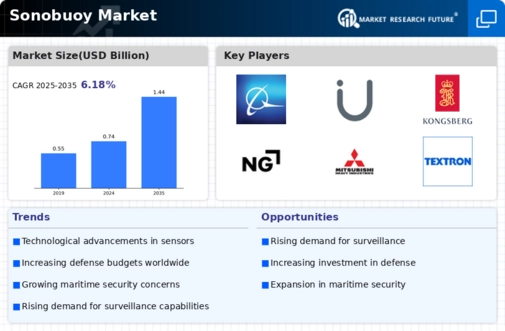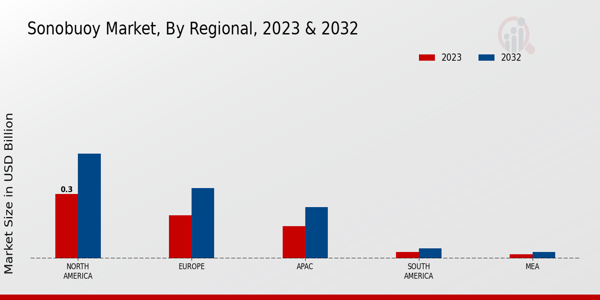Market Analysis
Sonobuoy Market (Global, 2023)
Introduction
The Sonobuoy Market is poised to play a critical role in the evolving landscape of maritime surveillance and underwater acoustics, driven by advancements in technology and increasing demand for effective anti-submarine warfare capabilities. As nations prioritize their naval defense strategies, the deployment of sonobuoys—buoyant devices equipped with sensors to detect and classify underwater sounds—has gained prominence. This market is characterized by a diverse range of applications, including military operations, environmental monitoring, and scientific research, reflecting the multifaceted utility of sonobuoys in both defense and civilian sectors. The integration of cutting-edge technologies such as artificial intelligence and machine learning into sonobuoy systems is expected to enhance their operational efficiency and data analysis capabilities, further expanding their market potential. Additionally, geopolitical tensions and the need for enhanced maritime security are driving investments in sonar technologies, positioning the Sonobuoy Market as a vital component of modern naval operations and strategic defense initiatives.
PESTLE Analysis
- Political
- In 2023, the geopolitical landscape has a direct impact on the Sonobuoy market, particularly due to increased military spending in response to rising tensions in various regions. For instance, the U.S. Department of Defense allocated approximately $1.2 billion specifically for anti-submarine warfare capabilities, which includes the procurement of advanced sonobuoys. Additionally, international collaborations, such as the AUKUS pact, have led to joint exercises and technology sharing, further driving demand for sonobuoy systems among allied nations.
- Economic
- The global defense budget has seen a notable increase, with countries like India and China reporting defense expenditures of $76 billion and $293 billion respectively in 2023. This economic focus on defense spending is expected to bolster the sonobuoy market as nations prioritize maritime security and anti-submarine warfare capabilities. Furthermore, the rising costs of raw materials, with an estimated increase of 15% in the price of key components like aluminum and titanium, could impact production costs and pricing strategies in the sonobuoy sector.
- Social
- Public perception of military spending and defense technology is evolving, with a growing emphasis on national security and maritime safety. In 2023, surveys indicated that 68% of the population in the U.S. supports increased funding for naval capabilities, reflecting a societal shift towards prioritizing defense readiness. This social sentiment is likely to influence government policies and funding allocations towards advanced technologies, including sonobuoys, as citizens demand enhanced protection against potential maritime threats.
- Technological
- Technological advancements in sonar technology are rapidly transforming the sonobuoy market. In 2023, the introduction of digital sonobuoys, which utilize advanced signal processing algorithms, has improved detection capabilities by up to 30% compared to traditional models. Additionally, the integration of artificial intelligence in data analysis is expected to enhance operational efficiency, with estimates suggesting that AI-driven systems could reduce analysis time by 40%, making them more attractive to military operators.
- Legal
- Regulatory frameworks governing defense procurement and technology transfer are becoming increasingly stringent. In 2023, the U.S. government implemented new export control regulations that require additional licensing for the sale of advanced sonobuoy technologies to foreign nations, impacting international sales. Compliance with these regulations is crucial, as violations can result in penalties exceeding $1 million, thereby influencing the operational strategies of companies in the sonobuoy market.
- Environmental
- The environmental impact of military operations, including the use of sonobuoys, is under scrutiny in 2023. The U.S. Navy has committed to reducing its carbon footprint by 50% by 2030, which includes the development of environmentally friendly sonobuoy technologies. Additionally, the estimated cost of compliance with new environmental regulations is projected to reach $500 million annually for defense contractors, prompting a shift towards sustainable practices in the production and deployment of sonobuoys.
Porter's Five Forces
- Threat of New Entrants
- Medium - The sonobuoy market has moderate barriers to entry due to the need for specialized technology and expertise in underwater acoustics. While the market is growing, new entrants may face challenges in securing funding and establishing relationships with defense and maritime agencies, which are critical for success.
- Bargaining Power of Suppliers
- Low - The suppliers in the sonobuoy market are relatively numerous, providing various components and materials. This abundance reduces their bargaining power, as manufacturers can switch suppliers without significant cost implications. Additionally, technological advancements have led to more suppliers entering the market.
- Bargaining Power of Buyers
- High - Buyers in the sonobuoy market, primarily government and military organizations, hold significant bargaining power due to their ability to influence contracts and demand specific features. The limited number of large-scale buyers means that they can negotiate better terms and prices, impacting manufacturers' margins.
- Threat of Substitutes
- Medium - While there are alternative technologies for underwater surveillance and monitoring, such as autonomous underwater vehicles (AUVs) and other sonar systems, the unique capabilities of sonobuoys in certain applications limit the threat of substitutes. However, advancements in alternative technologies could pose a risk in the future.
- Competitive Rivalry
- High - The sonobuoy market is characterized by intense competition among established players, including defense contractors and technology firms. The need for continuous innovation and the pressure to meet government contracts drive rivalry, leading to aggressive marketing strategies and price competition.
SWOT Analysis
Strengths
- Advanced technology integration enhancing detection capabilities.
- Strong demand from military and defense sectors for maritime surveillance.
- Established relationships with key defense contractors and government agencies.
Weaknesses
- High production and development costs limiting market entry for new players.
- Dependence on government contracts which can be subject to budget cuts.
- Limited commercial applications compared to military uses.
Opportunities
- Growing interest in anti-submarine warfare due to geopolitical tensions.
- Potential for innovation in sonobuoy technology, such as AI integration.
- Expansion into emerging markets with increasing naval capabilities.
Threats
- Intense competition from established defense firms and new entrants.
- Technological obsolescence due to rapid advancements in alternative surveillance methods.
- Regulatory changes affecting defense spending and procurement processes.
Summary
The Sonobuoy Market in 2023 is characterized by strong technological capabilities and a robust demand from military sectors, but it faces challenges such as high costs and reliance on government contracts. Opportunities for growth exist in the form of geopolitical tensions and technological innovations, while threats from competition and regulatory changes could impact market dynamics. Strategic focus on innovation and diversification into emerging markets may enhance resilience and growth potential.












Leave a Comment